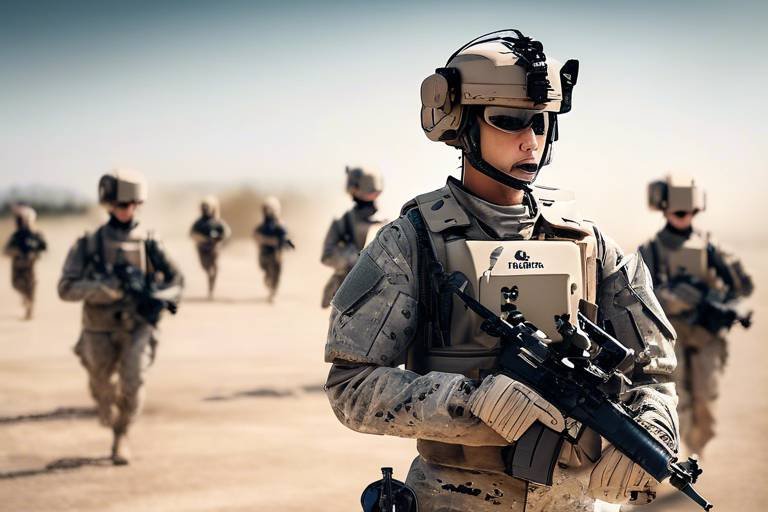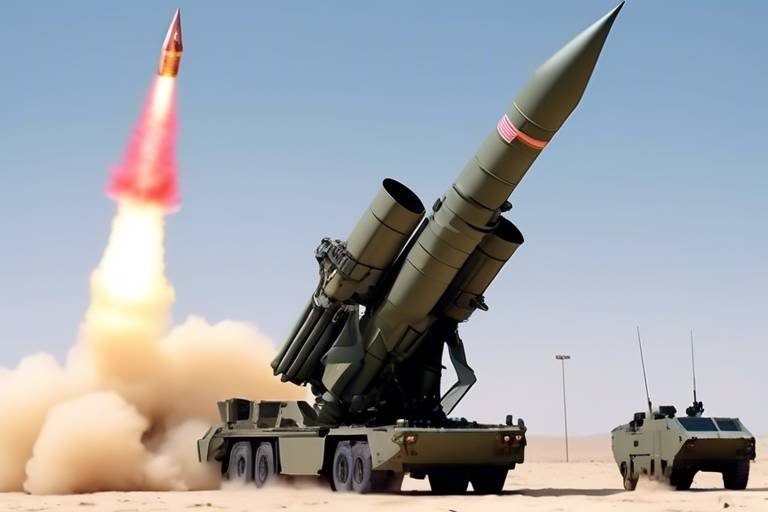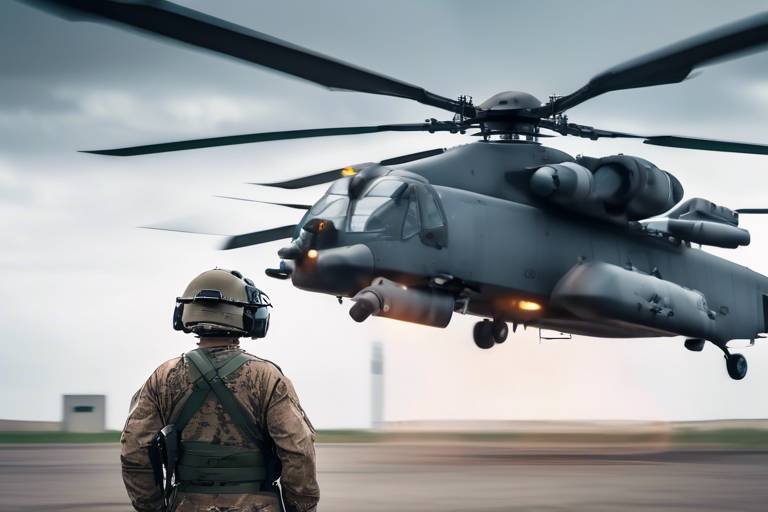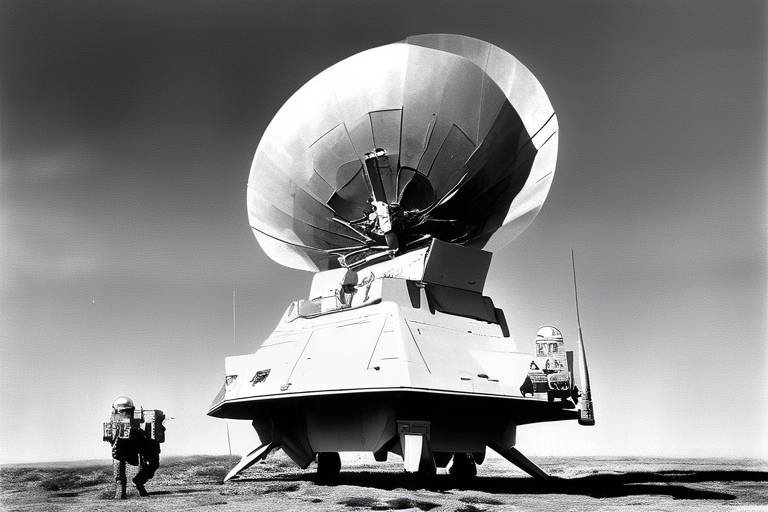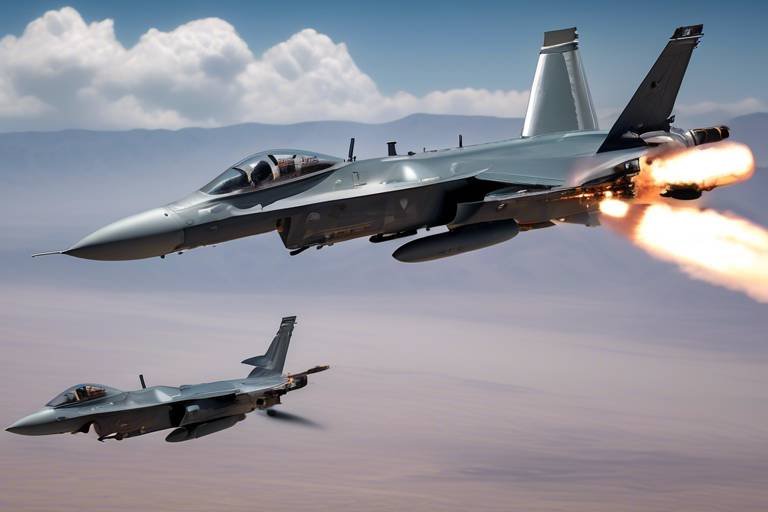The Role of AI in Transforming Military Training Programs
In today's rapidly evolving world, the integration of artificial intelligence (AI) into military training programs is not just a trend—it's a revolution. Imagine a training environment where soldiers can engage in realistic combat scenarios without the inherent risks of live exercises. This is the promise of AI, as it enhances the effectiveness, efficiency, and adaptability of military training. From creating immersive simulations to customizing training regimens based on individual performance, AI is reshaping how armed forces prepare for the challenges of modern warfare.
AI-driven technologies are not merely supplementary tools; they are becoming the backbone of military readiness. By leveraging advanced algorithms and data analytics, military leaders can make informed decisions that enhance operational capabilities. The ability to provide immediate feedback and track performance longitudinally means that soldiers can refine their skills in real-time, leading to a more competent and prepared force. As we delve deeper into this topic, we will explore the various aspects of AI integration, its benefits, challenges, and future implications for military readiness.
Imagine stepping into a training environment that feels as real as the battlefield, yet is completely safe. AI-powered simulations offer exactly that. These technologies create realistic training environments where soldiers can experience combat scenarios without the risks associated with live training. Through immersive experiences, soldiers can enhance their decision-making skills and tactical awareness. For instance, a soldier can engage in a simulated urban warfare scenario, facing dynamic challenges that require quick thinking and adaptability. This not only prepares them for real-life situations but also builds confidence in their abilities.
One of the most exciting aspects of AI in military training is its ability to create personalized training programs. Traditional training often adopts a one-size-fits-all approach, which can overlook individual strengths and weaknesses. However, AI analyzes performance metrics to tailor training regimens specifically for each soldier. This means that a soldier struggling with marksmanship can receive targeted instruction, while another excelling in strategy can be challenged with advanced tactics. This level of customization ensures that every soldier is not just trained, but optimized for their unique role within the military.
With AI, the days of subjective assessments are fading. AI utilizes data analytics to monitor and evaluate soldier performance in real-time. This capability provides military leaders with valuable insights into training effectiveness and identifies areas needing improvement. For example, if a soldier consistently struggles during simulations, data analytics can pinpoint specific skills that require additional focus. This leads to a more informed and effective training strategy, ultimately resulting in better preparedness for actual combat situations.
Imagine receiving feedback on your performance as soon as you complete a training exercise. AI systems can deliver immediate feedback to trainees, allowing for rapid adjustments and learning. This real-time feedback loop enhances skill acquisition and retention, making training more productive. Soldiers can immediately understand their mistakes and correct them, leading to a more efficient learning process.
AI can also track soldier performance over time, providing a comprehensive view of development and progress. This longitudinal data is crucial for military leaders as it helps them make informed decisions regarding personnel readiness and training strategies. By analyzing trends in performance, commanders can identify who is ready for advancement and who may need additional support.
The use of virtual and augmented reality in military training is another area where AI shines. These technologies create engaging and interactive learning experiences that foster better situational awareness and strategic thinking. Soldiers can practice in a virtual environment that mimics real-world conditions, enhancing their ability to react under pressure. This immersive training not only prepares them for the battlefield but also makes the learning process more engaging and effective.
Implementing AI in military training programs can lead to significant cost savings. By reducing the need for physical resources and allowing for more efficient training schedules, military budgets can be optimized. This financial efficiency is crucial, especially in times when resources are limited. AI helps military units maximize their training capabilities while minimizing waste, ensuring that every dollar spent contributes to mission readiness.
AI plays a key role in optimizing training resources by analyzing usage patterns and identifying areas for improvement. This ensures that military units can make the most of their training capabilities, leading to a more effective and efficient process. For example, if a training facility is underutilized, AI can suggest adjustments to schedules or resource allocation to improve usage.
Investing in AI technology for training can yield long-term financial benefits. Enhanced overall mission readiness and reduced costs associated with traditional training methods make AI a strategic investment for sustainable military operations. By embracing AI, military organizations can ensure that they are not just reactive but proactive in their training approaches, ultimately leading to a stronger defense posture.
Despite its advantages, integrating AI into military training poses challenges. Technological limitations, resistance to change, and ethical considerations are just a few hurdles that must be addressed for successful adoption. Navigating these challenges is essential to ensure that AI can be effectively implemented in military settings.
The rapid pace of AI development can outstrip the military's ability to adapt. Ensuring that infrastructure and personnel are equipped to handle these advancements is critical for effective implementation. This requires ongoing training and investment in technology to keep pace with the changes.
The use of AI in military contexts raises ethical questions about decision-making and accountability. As machines take on more responsibilities, navigating these concerns is vital to maintain trust and integrity in military operations. Establishing clear guidelines and ethical frameworks will be essential as AI becomes more integrated into military training.
The future of military training will likely see even greater integration of AI technologies. Advancements in machine learning and robotics will shape how soldiers are trained. Continuous adaptation will be key to staying ahead in an ever-evolving battlefield landscape. As AI technology evolves, new tools and methods will emerge, further enhancing training capabilities.
Staying informed about emerging technologies will be crucial for military leaders to maintain effective training programs. The continuous evolution of AI means that new solutions will constantly be available, offering opportunities for improved training methodologies.
The future of military training will focus on creating continuous learning environments supported by AI. This approach fosters adaptability and resilience among soldiers, ensuring they are prepared for any situation. In a world where change is the only constant, equipping soldiers with the tools to learn and adapt is more important than ever.
- How does AI improve military training? AI enhances military training by providing realistic simulations, personalized training programs, and real-time feedback, leading to more effective and efficient training.
- What are the challenges of implementing AI in military training? Challenges include technological barriers, resistance to change, and ethical considerations that must be navigated for successful integration.
- What is the future of AI in military training? The future will likely see greater integration of AI technologies, continuous learning environments, and emerging tools that enhance training capabilities.

AI-Driven Simulation Technologies
Artificial Intelligence has opened a new frontier in military training through . Imagine a training ground where soldiers can engage in realistic combat scenarios without the inherent risks of live exercises. This is not just a futuristic dream; it's a present-day reality. These AI-powered simulations create immersive environments that replicate the chaos and unpredictability of actual warfare. Soldiers can practice their skills in a safe space, boosting their confidence and tactical decision-making abilities.
One of the most significant advantages of these simulations is the ability to provide real-time feedback. As soldiers navigate through various scenarios, the AI analyzes their actions and decisions, offering immediate insights into their performance. This feedback loop is crucial; it allows trainees to learn from their mistakes on the spot, making adjustments that enhance their skills. For instance, if a soldier fails to communicate effectively during a simulated mission, the AI can highlight this issue, prompting them to focus on improving their communication skills in subsequent training sessions.
Moreover, the adaptability of AI-driven simulations means that they can be tailored to meet the specific needs of different military units. Customizable scenarios can be designed to reflect the unique challenges that a unit might face in their operational environment. Whether it's urban warfare, counter-terrorism, or peacekeeping missions, these simulations can mimic the conditions soldiers will encounter, ensuring that training is relevant and effective.
Additionally, the integration of machine learning algorithms into these simulations allows for continuous improvement. As more soldiers participate in training, the AI learns from their interactions, refining the scenarios to make them even more realistic and challenging. This evolution keeps the training programs dynamic, ensuring that soldiers are always prepared for the unexpected.
To illustrate the impact of AI-driven simulations, consider the following table that summarizes their key benefits:
| Benefit | Description |
|---|---|
| Realism | Provides lifelike scenarios that mimic actual combat situations. |
| Immediate Feedback | Offers real-time performance analysis to enhance learning. |
| Customization | Allows for tailored training relevant to specific missions. |
| Continuous Improvement | Utilizes machine learning to evolve scenarios based on user interactions. |
In summary, AI-driven simulation technologies are transforming military training by providing a safe, effective, and adaptable learning environment. As these technologies continue to evolve, they promise to enhance the readiness and effectiveness of military personnel, ensuring that they are well-prepared to face the challenges of modern warfare.
- What are AI-driven simulation technologies? These are advanced training tools that use artificial intelligence to create realistic combat scenarios for military training.
- How do these simulations improve training? They provide immersive experiences, real-time feedback, and customizable scenarios that enhance soldiers' skills and decision-making abilities.
- Can these simulations be tailored for specific military units? Yes, AI-driven simulations can be customized to reflect the unique challenges and operational environments of different units.
- What role does machine learning play in these simulations? Machine learning allows the simulations to continuously improve by analyzing soldier interactions and refining scenarios over time.

Personalized Training Programs
In the ever-evolving landscape of military training, personalization has emerged as a game-changer. Thanks to the integration of artificial intelligence (AI), military training programs can now be tailored to meet the unique needs of each soldier. Imagine a training regimen designed specifically for you, one that recognizes your strengths and weaknesses, and adapts accordingly. This is not just a dream; it's the reality that AI brings to the table.
One of the most significant advantages of personalized training is the ability to track individual performance metrics in real-time. AI systems analyze data such as reaction times, decision-making processes, and tactical execution. This information is then used to create a customized training plan that focuses on areas needing improvement while enhancing existing skills. For instance, if a soldier excels in marksmanship but struggles with tactical simulations, the AI can adjust their training schedule to include more scenarios that challenge their strategic thinking.
To illustrate this, consider a soldier who has shown exceptional aptitude in physical fitness but lacks experience in urban warfare tactics. The AI can develop a training program that includes:
- **Enhanced physical conditioning** to prepare for the demands of urban environments.
- **Simulated urban combat scenarios** that focus on decision-making under pressure.
- **Targeted feedback** to improve situational awareness and tactical responses.
This level of customization not only boosts individual performance but also contributes to overall unit effectiveness. When every soldier is trained according to their specific needs, the entire team becomes more cohesive and capable. Moreover, this personalized approach fosters a sense of ownership and accountability among soldiers, encouraging them to take charge of their development.
However, implementing personalized training programs isn’t without its challenges. The military must ensure that the necessary infrastructure is in place to support AI technology. This includes training personnel to effectively use these systems and ensuring that data privacy and security measures are robust. Additionally, it’s crucial to maintain a balance between personalized training and standardized military protocols to ensure that all soldiers meet the essential requirements for their roles.
Looking ahead, the potential for AI-driven personalized training programs is immense. As technology continues to advance, we can expect even more sophisticated algorithms that can predict training needs based on a soldier’s historical performance and evolving military tactics. This will lead to a more agile and responsive military force, ready to tackle the challenges of modern warfare.
- How does AI personalize military training? AI analyzes individual performance data to create tailored training programs that focus on specific strengths and weaknesses.
- What are the benefits of personalized training? Personalized training enhances individual performance, boosts unit effectiveness, and fosters a sense of ownership among soldiers.
- Are there challenges in implementing personalized training? Yes, challenges include ensuring proper infrastructure, training personnel, and maintaining data privacy and security.
- What does the future hold for personalized training in the military? The future will likely see more advanced algorithms and AI capabilities that further enhance the customization of training programs.
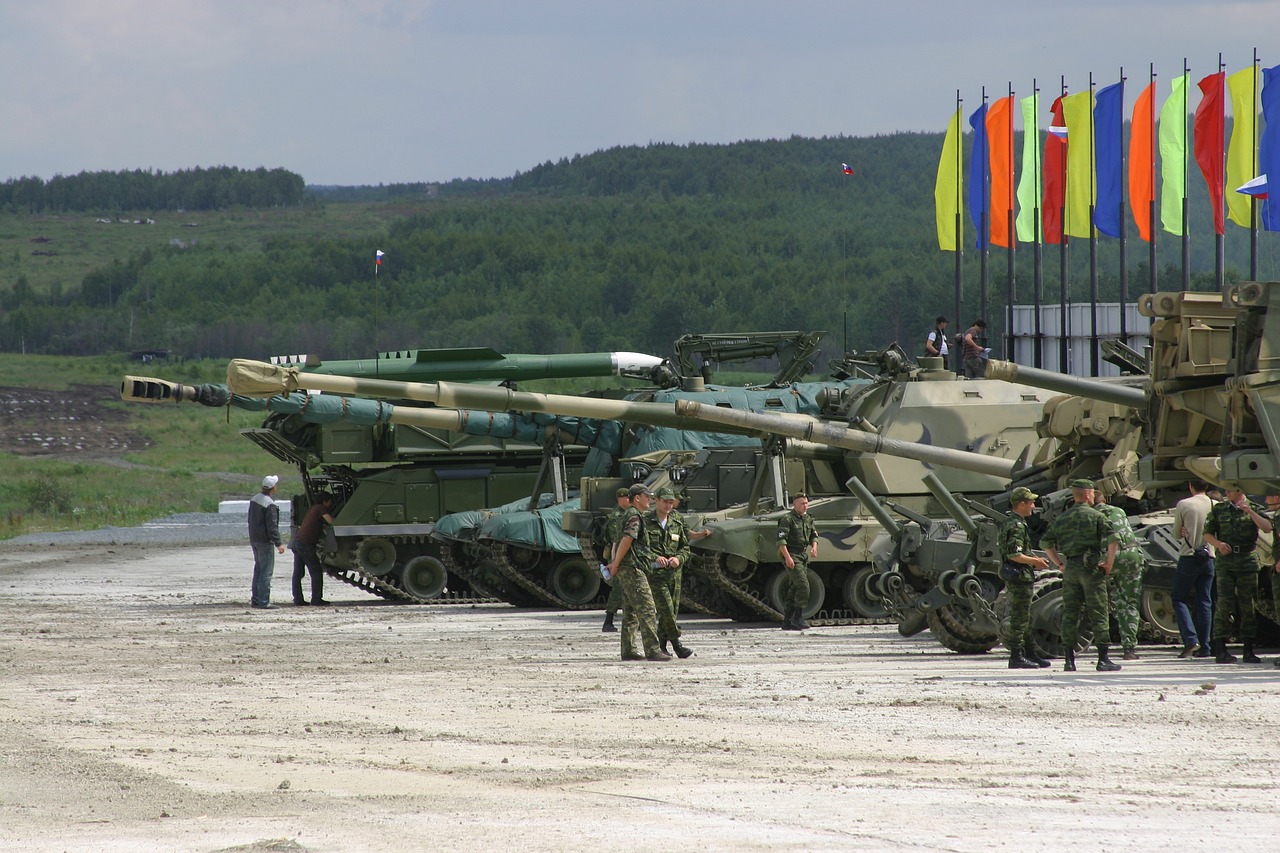
Data Analytics in Performance Assessment
In the modern battlefield, the ability to assess and enhance soldier performance is more crucial than ever. Data analytics plays a pivotal role in this process, offering a comprehensive approach to performance assessment that goes beyond traditional methods. By leveraging advanced algorithms and real-time data collection, military leaders can gain deep insights into how each soldier is performing during training exercises. This not only allows for immediate adjustments but also fosters a culture of continuous improvement.
Imagine a scenario where a soldier is engaged in a simulated combat situation. With AI-driven analytics, every movement, decision, and reaction is tracked and analyzed. This data can reveal patterns in behavior, highlighting strengths such as quick decision-making or areas needing improvement, like communication under pressure. The beauty of this system lies in its ability to provide a personalized training experience. For example, if a soldier struggles with tactical maneuvers, the AI can recommend specific drills tailored to enhance those skills.
Moreover, the integration of data analytics allows for the tracking of performance metrics over time. This longitudinal analysis is invaluable as it provides a holistic view of a soldier's development. Leaders can identify trends, such as consistent improvement or stagnation, and adjust training programs accordingly. To illustrate this, consider the following table that outlines key performance metrics analyzed through data analytics:
| Performance Metric | Description | Importance |
|---|---|---|
| Decision-Making Speed | Time taken to make tactical decisions | Essential for survival in combat |
| Accuracy of Execution | Precision in following commands | Critical for mission success |
| Team Communication | Effectiveness of communication with team members | Vital for coordinated efforts |
| Stress Response | Performance under pressure | Important for real-world scenarios |
This table highlights just a few of the key metrics that can be monitored through AI analytics. By focusing on these areas, military training can become more targeted and effective. Furthermore, the ability to provide immediate feedback to soldiers based on their performance data fosters a rapid learning environment. Soldiers can receive tailored suggestions right after their training sessions, allowing them to make quick adjustments and reinforce learning.
In summary, the integration of data analytics in performance assessment is revolutionizing military training. By providing real-time insights and personalized feedback, military leaders can ensure that every soldier is not just prepared but also continuously improving. The future of military readiness hinges on the effective use of these technologies, making it imperative for military organizations to embrace this shift.
- What is the role of data analytics in military training?
Data analytics helps assess soldier performance in real-time, providing insights that enable personalized training and continuous improvement. - How does AI enhance decision-making in training?
AI analyzes data to identify patterns and suggest improvements, allowing soldiers to make better decisions during training exercises. - What are the benefits of personalized training programs?
Personalized training ensures that each soldier receives targeted instruction, optimizing their strengths and addressing weaknesses effectively. - Can data analytics predict future performance?
Yes, longitudinal performance tracking allows military leaders to identify trends and predict future performance based on past data.
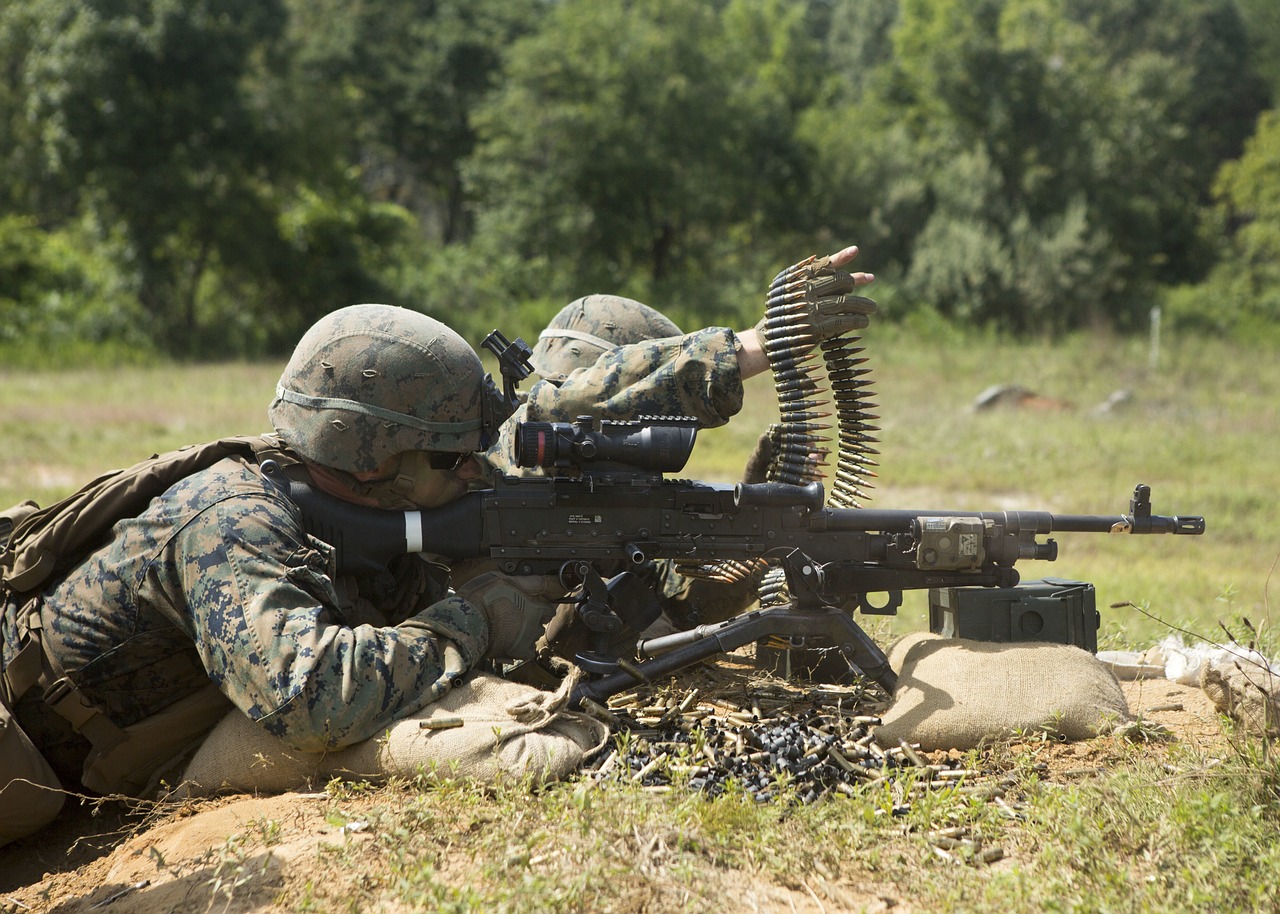
Feedback Mechanisms
In the fast-paced world of military training, the ability to adapt and improve is crucial. This is where powered by artificial intelligence come into play. Imagine a training scenario where soldiers are not only practicing their skills but are also receiving instant feedback that allows them to fine-tune their performance on the spot. This real-time feedback loop is revolutionizing how military personnel learn and develop their skills.
AI systems are designed to analyze a soldier's actions during training exercises and provide immediate insights into their performance. For instance, if a soldier makes a tactical error during a simulation, the AI can highlight the mistake and suggest alternative strategies to improve their decision-making. This kind of immediate correction is akin to having a personal coach who is always present, offering guidance and support.
Moreover, the feedback from AI is not just limited to pointing out mistakes. It also emphasizes strengths. By identifying what a soldier does well, AI can help build confidence and reinforce effective techniques. This dual approach—correcting errors while also celebrating successes—creates a balanced training environment where soldiers can thrive.
Another significant advantage of AI-driven feedback mechanisms is their ability to track progress over time. By continuously monitoring performance, AI can generate detailed reports that outline a soldier's development. These reports can include metrics such as reaction times, accuracy rates, and decision-making efficiency. Such data-driven insights are invaluable for military leaders who need to make informed decisions about training strategies and personnel readiness.
Incorporating feedback mechanisms into military training also fosters a culture of continuous learning. Soldiers become accustomed to receiving constructive criticism and using it to enhance their skills. This mindset not only improves individual performance but also contributes to the overall effectiveness of military units. When everyone is on the same page, working towards improvement, the entire team becomes more cohesive and capable.
To sum it up, the integration of AI feedback mechanisms in military training programs is a game changer. It provides soldiers with the tools they need to learn quickly and efficiently, ensuring that they are always prepared for the challenges they may face in the field. As technology continues to advance, we can expect these feedback systems to become even more sophisticated, further enhancing military readiness.
- How does AI provide feedback during military training?
AI analyzes soldiers' actions in real-time and offers insights on performance, highlighting both mistakes and strengths. - What are the benefits of immediate feedback?
Immediate feedback allows soldiers to correct errors on the spot, reinforcing learning and improving skills more rapidly. - Can AI track performance over time?
Yes, AI systems can generate detailed reports that track a soldier's progress, helping military leaders make informed decisions. - How does feedback foster a culture of learning?
By encouraging soldiers to embrace constructive criticism, AI feedback mechanisms promote continuous improvement and adaptability.
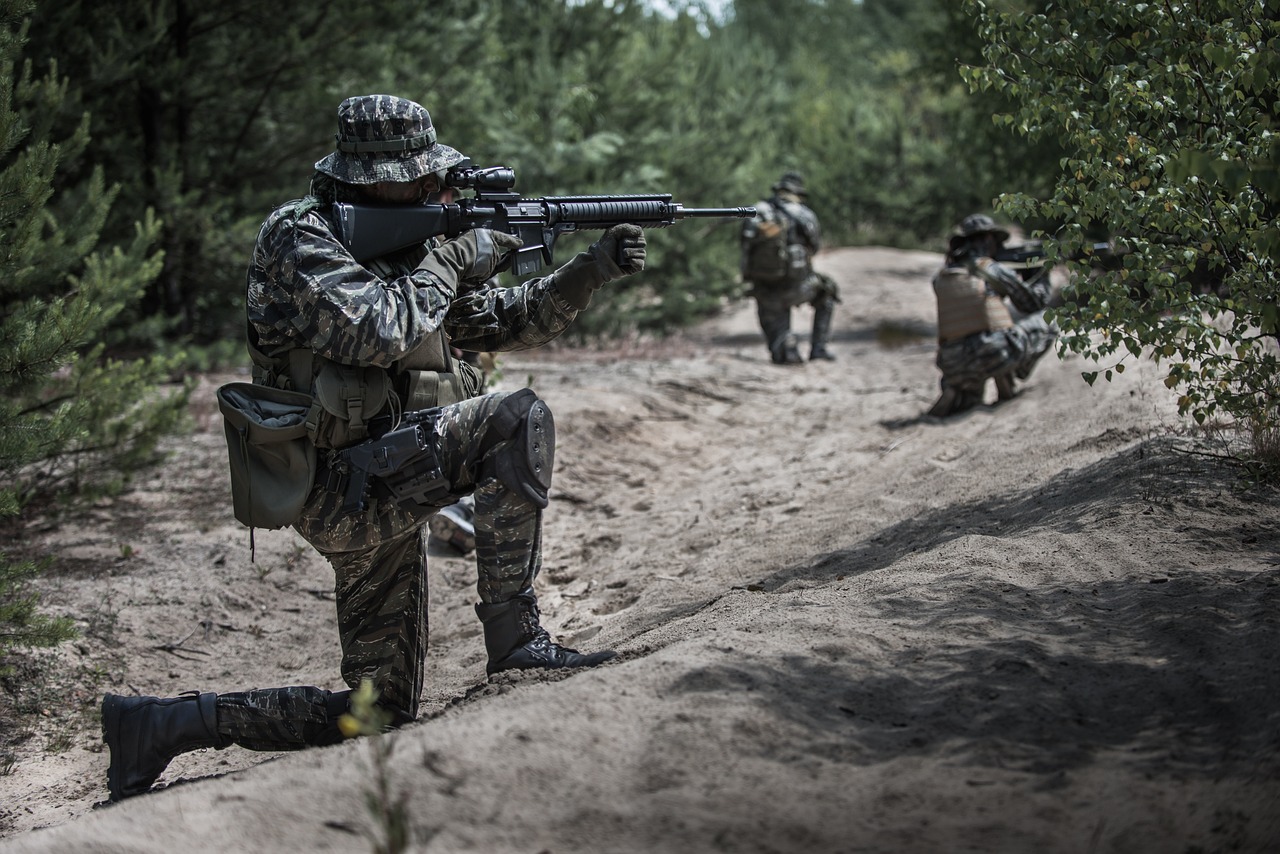
Longitudinal Performance Tracking
Longitudinal performance tracking is a groundbreaking aspect of integrating artificial intelligence into military training programs. This approach allows military leaders to gather and analyze data over an extended period, providing a comprehensive view of each soldier's development and progress. Imagine having a detailed map of a soldier's journey, where every training session, every skill acquired, and every challenge faced is documented and evaluated. This isn't just about numbers; it's about understanding the narrative of a soldier's growth.
With AI, tracking performance longitudinally means that data is collected continuously, rather than just at the end of a training cycle. This ongoing assessment enables trainers to identify trends and patterns in performance, which can be critical for tailoring training programs to meet the evolving needs of soldiers. For example, if a soldier consistently struggles with a specific skill, the AI can flag this issue for immediate attention, allowing instructors to intervene before the problem escalates.
Furthermore, the data collected through longitudinal tracking can be visualized in various formats, making it easier to digest and understand. For instance, a performance dashboard can be created, showcasing key metrics such as:
| Metric | Performance Over Time |
|---|---|
| Combat Readiness | Increased by 20% over 6 months |
| Skill Acquisition Rate | Improved by 15% in critical areas |
| Response Time in Simulations | Decreased by 10 seconds |
This kind of detailed analysis not only helps in understanding individual soldier performance but also assists military leaders in making informed decisions regarding personnel readiness. By having a clear picture of each soldier's strengths and weaknesses, commanders can optimize training strategies, ensuring that resources are allocated effectively. Moreover, this data-driven approach fosters a culture of accountability and continuous improvement within military units.
In addition to tracking performance, AI enables the creation of personalized development plans based on the insights gained from longitudinal data. These plans can outline specific goals for soldiers, ensuring that their training is not only relevant but also aligned with their career aspirations and the needs of the military. This tailored approach can significantly enhance motivation and engagement, as soldiers see a clear path for their professional growth.
In conclusion, longitudinal performance tracking powered by AI is transforming how military training is conducted. By providing a comprehensive and dynamic view of soldier performance, it empowers military leaders to make better decisions, optimize training programs, and ultimately enhance the overall effectiveness of military operations. As the military continues to embrace these innovative technologies, the potential for improved readiness and resilience on the battlefield becomes increasingly promising.
- What is longitudinal performance tracking? Longitudinal performance tracking is a method of collecting and analyzing data over time to assess a soldier's development and performance in military training.
- How does AI enhance performance tracking? AI allows for continuous data collection and analysis, enabling military leaders to identify trends, tailor training programs, and intervene when necessary.
- What are the benefits of personalized training plans? Personalized training plans ensure that each soldier receives targeted instruction, optimizing their strengths and addressing weaknesses effectively, which can lead to improved performance.
- Can longitudinal tracking improve military readiness? Yes, by providing insights into individual and unit performance, longitudinal tracking helps military leaders make informed decisions that enhance overall mission readiness.
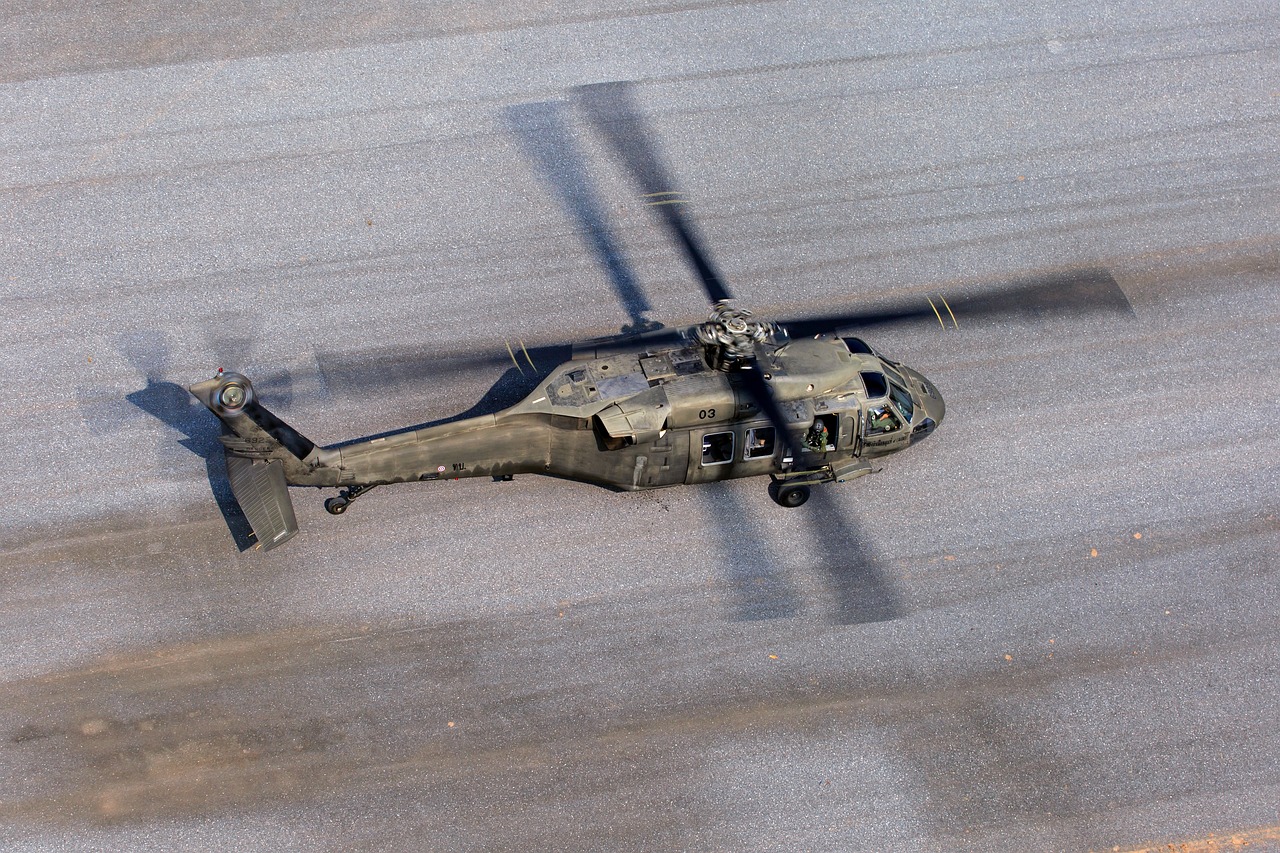
Integration of Virtual and Augmented Reality
In the ever-evolving landscape of military training, the integration of Virtual Reality (VR) and Augmented Reality (AR) is emerging as a game-changer. These technologies create immersive training environments that not only replicate real-world scenarios but also enhance the learning experience for soldiers. Imagine stepping into a virtual battlefield where every sound, movement, and tactical decision feels incredibly real. This is not just a fantasy; it is the new frontier in military training.
Virtual Reality allows soldiers to engage in fully immersive simulations, where they can practice their skills in a controlled yet realistic environment. This technology lets them experience high-stress situations without the physical dangers associated with live training. For example, soldiers can practice urban warfare tactics in a digital city that mirrors actual combat zones. On the other hand, Augmented Reality overlays digital information onto the real world, providing real-time data and insights. This means that while a soldier is on the ground, they can receive crucial information about their surroundings, enemy positions, and mission objectives, all displayed through AR devices.
The benefits of integrating these technologies are profound:
- Enhanced Situational Awareness: Soldiers can better understand their environment, leading to improved decision-making skills.
- Increased Engagement: The interactive nature of VR and AR keeps soldiers engaged, making training sessions more enjoyable and effective.
- Reduced Training Costs: With fewer physical resources needed, military budgets can be allocated more effectively.
Furthermore, the adaptability of these technologies means that training can be tailored to meet the specific needs of different units or individual soldiers. For instance, a unit preparing for a deployment in a specific region can undergo targeted VR training that simulates the unique challenges they will face. This level of personalization not only maximizes training efficiency but also boosts confidence among soldiers, knowing they are well-prepared for their missions.
However, integrating VR and AR into military training is not without its challenges. Issues such as technological readiness and cost of implementation can pose significant hurdles. Military leaders must ensure that the necessary infrastructure is in place to support these advanced technologies. Additionally, there is a need for continuous updates and maintenance of the software and hardware used in training programs.
As we look to the future, the potential for VR and AR in military training is vast. With advancements in technology, we can expect even more sophisticated simulations that provide soldiers with unparalleled training experiences. The military must embrace these innovations to stay ahead in an increasingly complex battlefield landscape. By investing in VR and AR technologies, the armed forces can ensure that their personnel are not only ready for today’s challenges but are also equipped to adapt to the uncertainties of tomorrow.
- What is the difference between Virtual Reality and Augmented Reality?
Virtual Reality immerses users in a completely digital environment, while Augmented Reality overlays digital information onto the real world. - How can VR and AR improve military training?
These technologies provide realistic training scenarios, enhance situational awareness, and allow for personalized training experiences. - Are there any challenges in implementing VR and AR in military training?
Yes, challenges include technological readiness, cost of implementation, and the need for continuous updates and maintenance. - What is the future of VR and AR in military training?
The future looks promising, with ongoing advancements expected to create even more sophisticated training simulations.
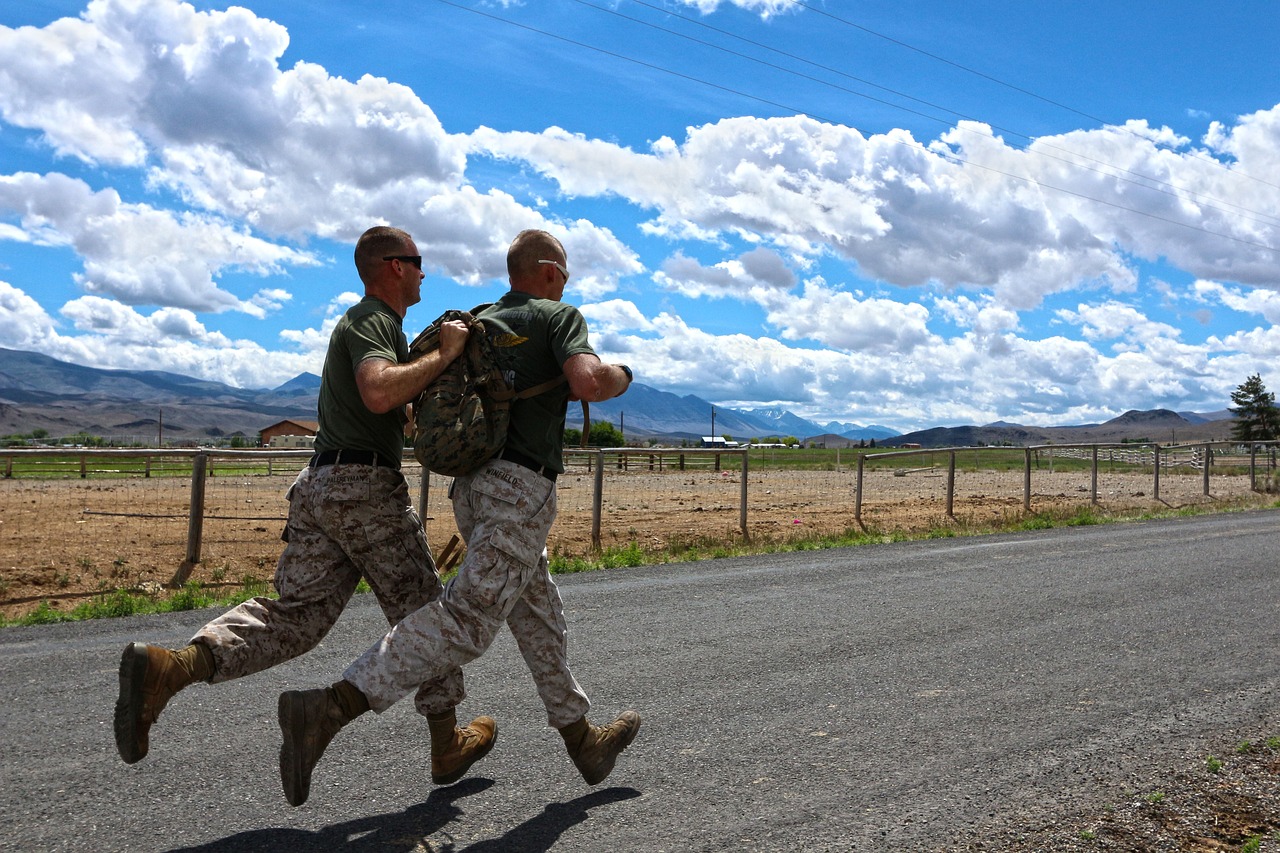
Cost-Effectiveness of AI Training Solutions
When we think about military training, the first thing that often comes to mind is the high costs associated with it. From extensive physical resources to personnel time, the financial burden can be overwhelming. However, with the advent of artificial intelligence (AI), the landscape is changing dramatically. AI training solutions are proving to be not just innovative but also incredibly cost-effective. By streamlining training processes, AI reduces the need for expensive live exercises, which often require significant logistical planning and resources.
One of the major advantages of AI in military training is its ability to create realistic simulations that can replace traditional live training exercises. Imagine being able to run a full-scale combat scenario in a virtual environment without the costs of ammunition, fuel, and other physical resources. This not only saves money but also allows for more frequent and varied training sessions. The ability to train under different conditions without the associated costs is a game-changer for military budgets.
Moreover, AI-driven training programs can optimize the use of existing resources. By analyzing data on how training resources are utilized, AI can identify inefficiencies and suggest improvements. For instance, if a particular training module is underutilized, military leaders can reallocate resources to enhance its use, thereby maximizing the overall effectiveness of training programs. This resource optimization ensures that every dollar spent contributes to enhancing soldier readiness.
To illustrate the potential savings, consider the following table that compares traditional training costs with AI-enhanced training solutions:
| Training Method | Estimated Cost per Soldier | Frequency of Training Sessions |
|---|---|---|
| Traditional Live Training | $5,000 | 2 sessions/month |
| AI-Enhanced Virtual Training | $1,500 | Weekly sessions |
This table clearly shows how AI-enhanced training can drastically reduce costs while increasing the frequency of training sessions. The potential for long-term financial benefits is significant. By investing in AI technologies, military organizations can not only enhance their operational readiness but also achieve substantial savings over time. These savings can then be redirected to other critical areas, such as advanced technology development or personnel welfare.
In conclusion, the integration of AI into military training programs is not merely a trend; it is a strategic move towards achieving cost-effectiveness and operational efficiency. As military budgets tighten and the demands for readiness increase, leveraging AI will be essential in ensuring that soldiers are well-prepared without breaking the bank.
- How does AI reduce training costs?
AI reduces costs by minimizing the need for physical resources, allowing for more frequent training sessions through realistic simulations. - What are the long-term financial benefits of AI in military training?
Investing in AI can lead to substantial savings over time and improve overall mission readiness, enabling funds to be allocated to other critical areas. - Can AI training solutions be customized?
Yes, AI can tailor training programs to meet the specific needs of individual soldiers, optimizing their strengths and addressing weaknesses effectively.
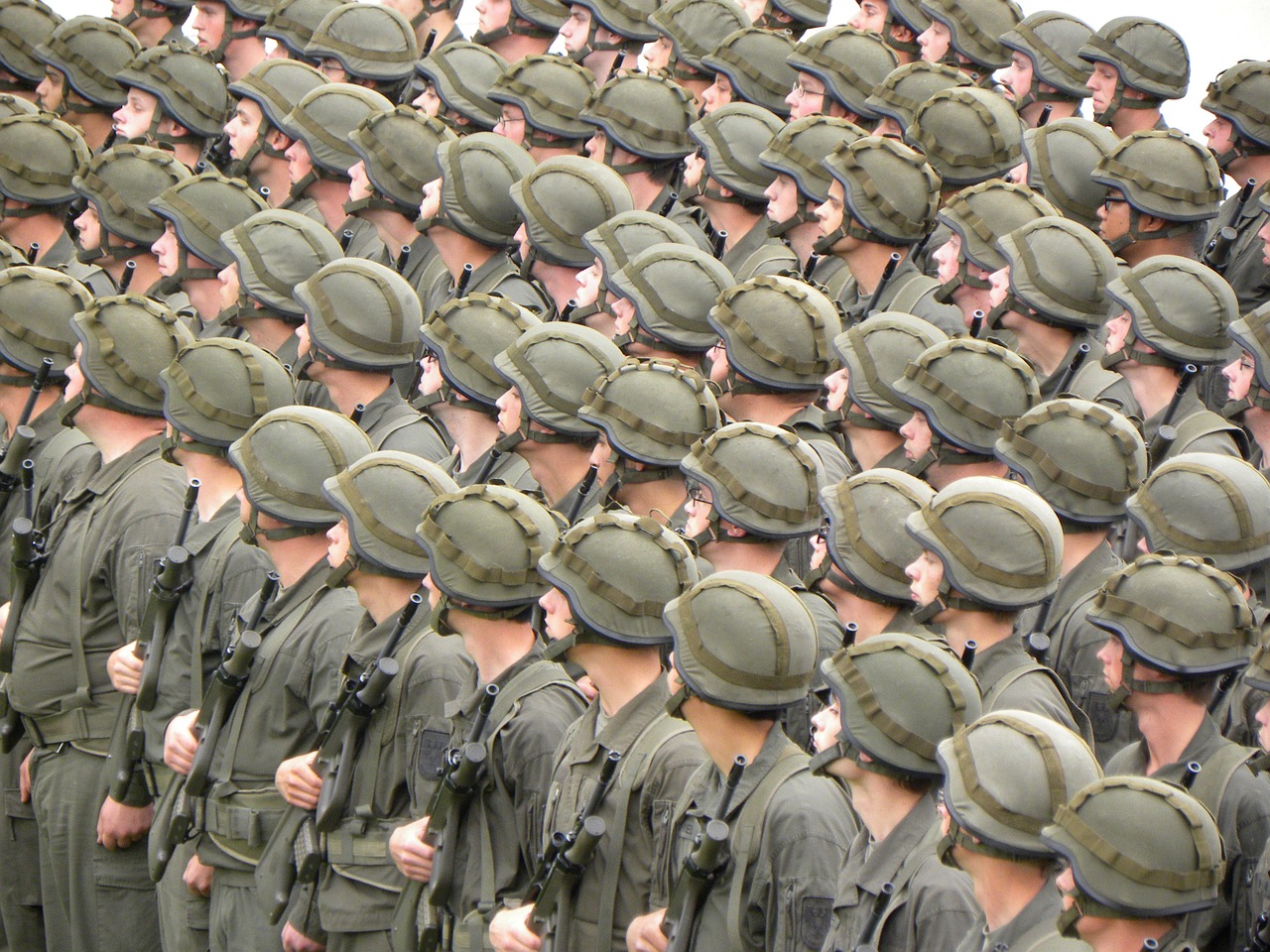
Resource Optimization
In the realm of military training, is not just a buzzword; it’s a necessity. With the integration of artificial intelligence, military units can analyze training resources more effectively than ever before. Imagine a scenario where every piece of equipment, every training hour, and every instructor's time is accounted for and utilized to its fullest potential. This is the promise of AI-driven resource optimization.
AI systems can sift through vast amounts of data to identify patterns in resource usage. For instance, they can reveal which training exercises yield the best results for specific units, or which equipment is underutilized. This level of insight allows military leaders to make informed decisions about where to allocate resources. By understanding these patterns, the military can:
- Reduce unnecessary expenditures on seldom-used equipment.
- Enhance training programs by focusing on the most effective methodologies.
- Ensure that personnel are trained on the latest and most relevant technologies.
Furthermore, AI can simulate various training scenarios, allowing commanders to experiment with different resource allocations without the risk of real-world consequences. This not only saves money but also provides valuable data on the effectiveness of various training strategies. For example, a military unit might use AI to determine the optimal number of personnel required for a specific training exercise, thus avoiding situations where too many or too few soldiers are involved.
To illustrate the impact of resource optimization, consider the following table that outlines potential savings and efficiencies gained through AI integration:
| Resource Type | Traditional Approach Cost | AI Optimized Approach Cost | Efficiency Gain (%) |
|---|---|---|---|
| Equipment Maintenance | $100,000 | $75,000 | 25% |
| Training Hours | $50,000 | $35,000 | 30% |
| Instructor Time | $40,000 | $28,000 | 30% |
As seen in the table, the shift from traditional methods to AI-optimized approaches can lead to significant cost savings across various resource types. These savings can then be redirected towards enhancing training programs or investing in new technologies, ultimately leading to a more capable and prepared military force.
In conclusion, resource optimization through AI is transforming how military training programs operate. By leveraging data analytics and AI-driven insights, military units can not only cut costs but also enhance the effectiveness of their training regimens. This optimization is essential for maintaining a competitive edge in a rapidly changing battlefield environment.
- What is resource optimization in military training?
Resource optimization refers to the strategic allocation and management of training resources to maximize efficiency and effectiveness, often enhanced through AI technologies. - How does AI improve resource optimization?
AI analyzes data on resource usage to identify patterns and inefficiencies, allowing military leaders to make informed decisions about resource allocation. - What are the financial benefits of AI in military training?
AI can lead to significant cost savings by optimizing resource use, reducing unnecessary expenses, and enhancing training effectiveness, ultimately improving overall mission readiness.

Long-Term Financial Benefits
Investing in artificial intelligence (AI) technology for military training is not just a fleeting trend; it represents a **strategic investment** that can yield substantial long-term financial benefits. Imagine a world where training costs are significantly reduced while simultaneously enhancing the effectiveness of soldiers. This is not just a dream—it's a reality that AI is ushering in. By leveraging AI-driven solutions, military organizations can streamline their operations, leading to better allocation of resources and ultimately, **cost savings**.
One of the most compelling aspects of AI in military training is its ability to **enhance overall mission readiness**. With AI systems, military units can conduct more efficient training sessions, minimizing downtime and maximizing the effectiveness of each training exercise. For instance, traditional training often requires extensive physical resources such as equipment, facilities, and personnel. AI can reduce these needs by providing virtual training environments that simulate real-world scenarios without the associated costs of live training. This not only conserves resources but also allows for more frequent and varied training exercises.
Moreover, the **long-term financial benefits** of AI implementation extend beyond mere cost savings. By improving the quality of training, AI helps ensure that soldiers are better prepared for actual combat situations. This preparedness can lead to a reduction in operational costs during missions, as well-trained soldiers are less likely to make costly mistakes. In essence, investing in AI is akin to investing in the **future of military operations**, where efficiency and effectiveness go hand in hand.
Additionally, AI can provide valuable analytics that inform budgetary decisions. By analyzing training data, military leaders can identify which programs yield the best results and allocate funds accordingly. This data-driven approach ensures that financial resources are spent wisely, focusing on what truly enhances military readiness. For example, if data shows that certain training modules lead to higher performance metrics, those programs can be prioritized in future budgets. This not only optimizes spending but also fosters a culture of continuous improvement.
In summary, the integration of AI in military training is a game-changer that offers long-term financial benefits through:
- Cost Reduction: Lower operational costs associated with live training.
- Enhanced Readiness: Better-prepared soldiers lead to fewer mistakes and lower mission costs.
- Data-Driven Decisions: Analytics that guide budget allocation and optimize training expenditures.
As military organizations continue to embrace AI, the financial implications will only grow more favorable. The initial investment in AI technology will undoubtedly pay off, creating a more efficient, effective, and financially sound military training environment.
- What are the primary benefits of using AI in military training? AI enhances training effectiveness, reduces costs, and allows for personalized training experiences.
- How does AI improve decision-making in training? AI-powered simulations provide realistic scenarios that help soldiers develop critical thinking and tactical skills.
- Are there any risks associated with AI in military training? Yes, challenges include technological barriers and ethical considerations that need to be addressed for successful implementation.
- What future advancements can we expect in AI military training? We can anticipate greater integration of emerging technologies, creating continuous learning environments for soldiers.

Challenges in AI Implementation
Integrating artificial intelligence into military training programs is not without its challenges. While the potential benefits are enormous, the path to successful implementation can be fraught with obstacles. One of the most significant challenges is the rapid pace of technological advancement. As AI evolves, the military must keep up with these changes to ensure that their training programs remain relevant and effective. This often requires substantial investment in both infrastructure and personnel training.
Moreover, there is a natural resistance to change within military organizations. Many personnel are accustomed to traditional training methods, and introducing AI can be met with skepticism. This resistance can hinder the adoption of new technologies, making it essential for military leaders to foster a culture of innovation and adaptability. They must communicate the benefits of AI clearly and provide training to help personnel transition smoothly into these new systems.
Another critical aspect to consider is the ethical implications of using AI in military contexts. The deployment of AI raises questions about accountability and decision-making processes. For instance, if an AI system makes a mistake during training simulations, who is responsible? Addressing these ethical considerations is vital to maintaining trust within the ranks and ensuring that AI is used responsibly. Here are some ethical concerns that need to be navigated:
- Accountability: Determining who is responsible for AI-driven decisions.
- Transparency: Ensuring that AI algorithms are understandable and justifiable.
- Bias: Mitigating any biases in AI systems that could affect training outcomes.
Lastly, the technical infrastructure required to support AI systems can be a barrier to implementation. Many military organizations may not have the necessary hardware or software to fully utilize AI technologies. This gap necessitates a strategic investment in upgrading existing systems and ensuring that personnel are adequately trained to operate and maintain these new technologies.
In summary, while the integration of AI into military training offers a myriad of benefits, it is essential to address the challenges that accompany this transformation. By focusing on technological readiness, fostering a culture of innovation, and considering ethical implications, military leaders can pave the way for a more effective and efficient training environment.
Q: What are the main challenges of implementing AI in military training?
A: The main challenges include technological barriers, resistance to change, and ethical considerations regarding accountability and decision-making.
Q: How can military organizations overcome resistance to AI?
A: By fostering a culture of innovation, clearly communicating the benefits of AI, and providing comprehensive training for personnel.
Q: What ethical concerns are associated with AI in military contexts?
A: Key ethical concerns include accountability for AI-driven decisions, transparency of AI algorithms, and potential biases in AI systems.
Q: Why is technological infrastructure important for AI implementation?
A: Adequate technological infrastructure ensures that military organizations can effectively utilize AI technologies and support personnel training.

Technological Barriers
Integrating artificial intelligence into military training programs is not as straightforward as one might hope. One of the most significant hurdles is the rapid pace of technological advancement. As AI evolves, the military must ensure that its infrastructure can keep up. Imagine trying to fit a sleek, high-performance sports car into a parking space designed for a compact sedan; it just doesn't work. Similarly, if the military's technological framework isn't robust enough, it can hinder the effective use of AI.
Furthermore, there is often a gap between the development of AI technologies and their practical application within military settings. This gap can lead to challenges in implementation, as military personnel may not be adequately trained to utilize these advanced systems. It's akin to giving someone a state-of-the-art smartphone without providing them with the necessary instructions; they might struggle to leverage its full potential.
Another significant barrier is the integration of legacy systems. Many military organizations still rely on outdated technologies that were not designed to work with modern AI solutions. This can create compatibility issues that complicate the integration process. For instance, if a new AI-driven training module cannot communicate with existing simulation tools, it essentially becomes a standalone system, limiting its effectiveness.
Moreover, the cost of upgrading technological infrastructures can be prohibitive. Military budgets are often tight, and allocating funds for new technologies can lead to difficult decisions regarding where to invest. This is especially true when the benefits of AI may not be immediately apparent. As a result, some military branches may hesitate to invest in AI, fearing that the costs will outweigh the benefits.
Lastly, there is a cultural resistance to change within many military organizations. Soldiers and commanders are accustomed to traditional training methods that have proven effective over the years. Introducing AI into this environment can be met with skepticism, as personnel may question the reliability of machines over human judgment. Overcoming this resistance requires not only demonstrating the capabilities of AI but also building trust through consistent and successful implementation.
In conclusion, while the potential of AI in military training is immense, addressing these is crucial for successful integration. By investing in infrastructure, training personnel, and fostering a culture open to innovation, military organizations can harness the full power of AI to revolutionize their training programs.
- What are the main technological barriers to implementing AI in military training?
The primary barriers include the rapid pace of AI development, the integration of legacy systems, high costs of upgrades, and cultural resistance to change. - How can the military overcome these technological barriers?
Solutions include investing in infrastructure, providing adequate training for personnel, and fostering a culture that embraces technological innovation. - Why is it important to integrate AI into military training?
Integrating AI can enhance training effectiveness, improve decision-making skills, and allow for personalized training experiences, ultimately leading to better preparedness.

Ethical Considerations
As we delve into the integration of artificial intelligence in military training, it is imperative to address the that accompany this technological advancement. The introduction of AI into military contexts raises profound questions about the nature of decision-making and accountability. For instance, if an AI system is programmed to make tactical decisions in combat, who is held responsible if those decisions lead to unintended harm? This dilemma is not just theoretical; it has real-world implications that military leaders and policymakers must grapple with.
Moreover, the reliance on AI for training purposes can inadvertently lead to a dehumanization of warfare. Soldiers may become overly dependent on technology, potentially diminishing their critical thinking skills and emotional intelligence—qualities that are essential in high-stakes environments. The challenge lies in finding a balance between leveraging AI for efficiency and maintaining the human element that is vital in military operations.
Another critical aspect to consider is the potential for bias in AI algorithms. If the data used to train these systems is flawed or unrepresentative, the AI may produce biased outcomes, which could exacerbate existing inequalities. This concern is particularly relevant in military contexts, where decisions can have life-or-death consequences. Ensuring that AI systems are transparent and fair is essential for maintaining trust among military personnel and the public.
To navigate these ethical waters, military organizations must establish clear guidelines and frameworks that govern the use of AI. This includes:
- Accountability: Defining who is responsible for AI-driven decisions.
- Transparency: Ensuring that AI algorithms are understandable and auditable.
- Bias Mitigation: Implementing measures to reduce bias in AI training data.
- Human Oversight: Maintaining human involvement in critical decision-making processes.
Ultimately, the ethical considerations surrounding AI in military training are complex and multifaceted. As we move forward, it is crucial for military leaders to engage in ongoing discussions about these issues, ensuring that ethical principles guide the integration of AI technologies. This proactive approach will not only enhance the effectiveness of military training but also uphold the integrity and trustworthiness of military operations in a rapidly evolving technological landscape.
- What are the main ethical concerns regarding AI in military training? The primary concerns include accountability for AI decisions, potential bias in algorithms, and the risk of dehumanizing warfare.
- How can military organizations ensure ethical AI use? By establishing clear guidelines on accountability, transparency, bias mitigation, and maintaining human oversight in decision-making processes.
- Why is transparency important in AI systems? Transparency helps ensure that AI algorithms are understandable and auditable, fostering trust among military personnel and the public.
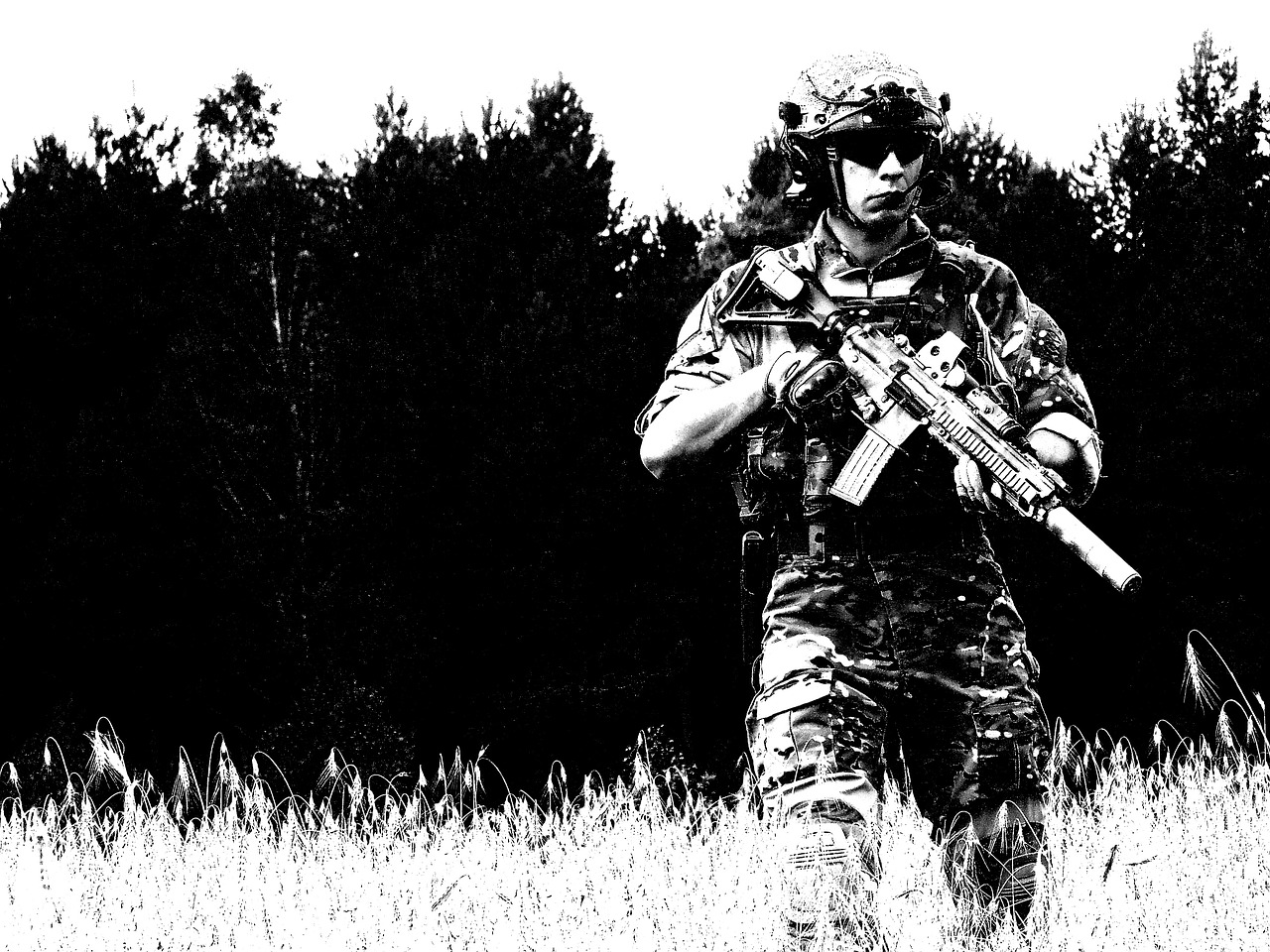
The Future of AI in Military Training
The future of military training is on the brink of a remarkable transformation, largely driven by the ever-evolving capabilities of artificial intelligence (AI). As we look ahead, it’s clear that AI technologies will not just play a role but will become the backbone of how soldiers are trained, prepared, and deployed. Imagine a world where training is not just a series of drills but a dynamic, adaptive process that evolves with each soldier's unique needs and the changing landscape of warfare. This is not science fiction; it’s the future we are stepping into.
One of the most exciting aspects of this future is the potential for emerging technologies to reshape training methodologies. As AI continues to advance, we can expect to see new tools and systems that leverage machine learning and data analytics to create personalized training experiences. For instance, AI algorithms could analyze a soldier's performance in real-time, identifying strengths and weaknesses, and then adapt training programs accordingly. This level of customization ensures that every soldier receives the specific training they need to excel, rather than a one-size-fits-all approach.
Moreover, the integration of virtual reality (VR) and augmented reality (AR) technologies will create immersive training environments that enhance situational awareness and decision-making skills. Picture soldiers donning VR headsets that transport them to realistic combat scenarios where they can practice their skills in a safe but challenging environment. This not only builds confidence but also prepares them for the unpredictability of real-world situations. The blend of AI with these immersive technologies will foster an engaging learning atmosphere, making training not just effective but also enjoyable.
In addition to personalized training and immersive technologies, the future of military training will likely emphasize the creation of continuous learning environments. This concept revolves around the idea that training should not be confined to specific periods but should be an ongoing process. AI can facilitate this by providing soldiers with access to training resources and simulations whenever they need them, allowing for constant skill enhancement. This adaptability is crucial in an ever-changing battlefield landscape where new challenges arise regularly.
However, as we embrace these advancements, it’s essential to remain aware of the potential challenges that come with them. The integration of AI into military training will require a cultural shift within military organizations. Leaders will need to foster an environment that encourages innovation and embraces change, while also addressing the ethical implications of using AI in military contexts. Trust, accountability, and transparency will be paramount as we navigate this new frontier.
In summary, the future of AI in military training is not just about technology; it’s about creating a more effective, efficient, and adaptable force. As we harness the power of AI, we will not only enhance the capabilities of our soldiers but also ensure that they are better prepared for the complexities of modern warfare. The journey ahead is filled with potential, and the military’s willingness to embrace these changes will determine how well they can meet the challenges of tomorrow.
- What are the key benefits of AI in military training?
AI enhances training effectiveness, personalizes learning experiences, and provides real-time feedback, ultimately improving soldier readiness. - How does AI personalize training programs?
AI analyzes individual performance metrics and adapts training regimens to address each soldier's strengths and weaknesses. - What role do VR and AR play in military training?
These technologies create immersive environments that allow soldiers to practice skills in realistic scenarios without the risks associated with live training. - What challenges does AI face in military training?
Challenges include technological barriers, resistance to change, and ethical considerations surrounding decision-making and accountability. - How will continuous learning environments benefit soldiers?
They provide ongoing access to training resources, ensuring soldiers can continuously improve their skills and adapt to new challenges.
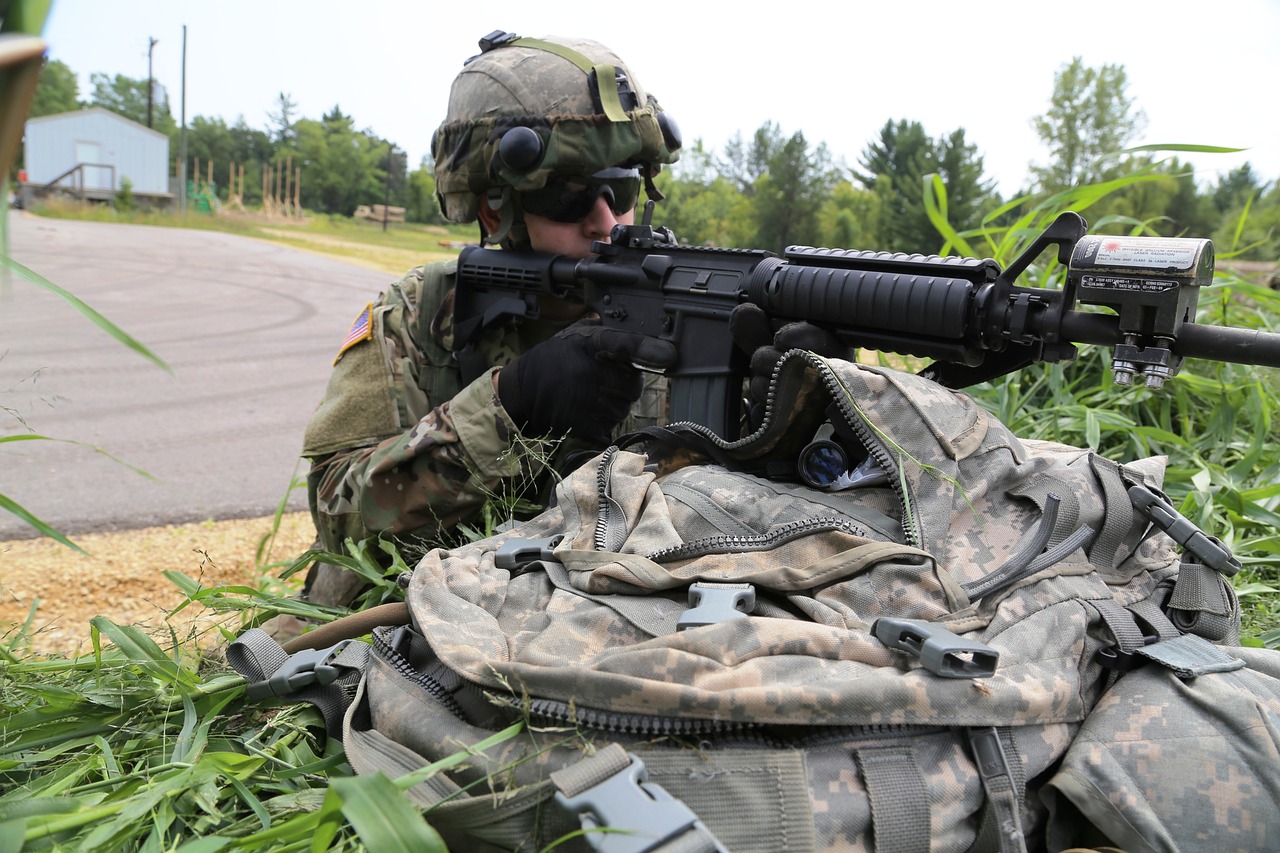
Emerging Technologies
The landscape of military training is undergoing a **remarkable transformation** thanks to the emergence of new technologies that harness the power of artificial intelligence. As we look to the future, it's clear that these innovations will play a pivotal role in shaping how soldiers are prepared for the complexities of modern warfare. One of the most exciting developments is the integration of **machine learning algorithms**, which allow training programs to evolve based on real-time data and feedback. This means that training scenarios can be dynamically adjusted to reflect current threats, ensuring that soldiers are always learning in the most relevant context.
Another groundbreaking technology is the use of **robotics** in training exercises. Imagine a training environment where robotic entities simulate enemy combatants, providing soldiers with a realistic and unpredictable adversary. This not only enhances combat readiness but also helps soldiers develop critical thinking and adaptability in the face of rapidly changing situations. The combination of AI and robotics creates an immersive training experience that traditional methods simply cannot match.
Moreover, advancements in **natural language processing** are making it easier for soldiers to interact with AI systems. These systems can understand and respond to spoken commands, allowing for a more intuitive training process. For instance, during a simulated mission, a soldier could communicate with an AI assistant that provides real-time tactical advice, enhancing decision-making skills without the constraints of traditional training methods.
In addition to these technological advancements, the military is also exploring the potential of **biometric sensors** to monitor soldiers' physiological responses during training. These sensors can track heart rate, stress levels, and fatigue, providing valuable data that can be used to tailor training programs to individual needs. By understanding how soldiers respond to various stressors, trainers can develop more effective strategies that not only improve performance but also prioritize the well-being of personnel.
As we embrace these emerging technologies, it's important to recognize the **collaborative nature** of their development. Military leaders are partnering with tech companies, universities, and research institutions to ensure that the training programs are not only cutting-edge but also grounded in the latest scientific insights. This collaboration fosters an environment of innovation, where ideas can be tested and refined in real-world scenarios.
In conclusion, the future of military training is bright, filled with the promise of emerging technologies that will redefine how soldiers are prepared for the challenges ahead. By leveraging AI, machine learning, robotics, and biometric monitoring, the military can create a training environment that is not only more effective but also more engaging. As we move forward, staying abreast of these advancements will be crucial for maintaining a competitive edge in military readiness.
- What role does AI play in military training? AI enhances training by providing realistic simulations, personalized training regimens, and real-time feedback.
- How do emerging technologies improve soldier readiness? Technologies like robotics and AI-driven analytics create immersive training environments that adapt to current threats.
- What are the ethical considerations of using AI in military training? The use of AI raises questions about accountability and decision-making, which must be addressed to maintain trust in military operations.
- How can biometric sensors be utilized in training? Biometric sensors monitor soldiers' physiological responses, allowing for tailored training programs that enhance performance and well-being.
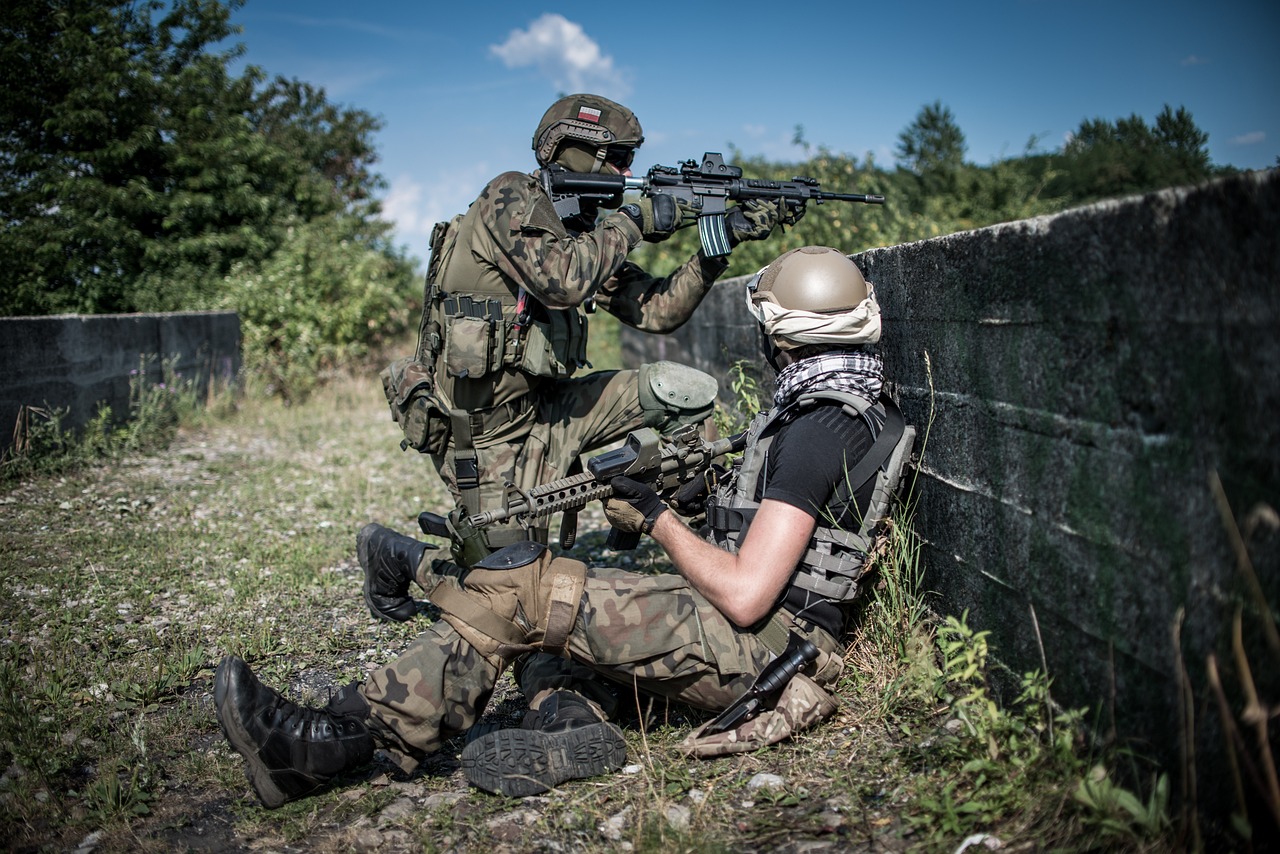
Continuous Learning Environments
This article explores how artificial intelligence is revolutionizing military training, enhancing effectiveness, efficiency, and adaptability. We will discuss various aspects of AI integration, its benefits, challenges, and future implications for military readiness.
AI-powered simulations offer realistic training environments, enabling soldiers to experience combat scenarios without the risks associated with live training. These technologies enhance decision-making skills and tactical awareness through immersive experiences.
Artificial intelligence allows for the customization of training regimens based on individual performance metrics. This personalization ensures that each soldier receives targeted instruction, optimizing their strengths and addressing weaknesses effectively.
AI utilizes data analytics to monitor and evaluate soldier performance in real-time. This capability provides valuable insights into training effectiveness and areas needing improvement, ultimately leading to better preparedness.
AI systems can deliver immediate feedback to trainees, allowing for rapid adjustments and learning. This real-time feedback loop enhances skill acquisition and retention, making training more productive.
AI can track soldier performance over time, providing a comprehensive view of development and progress. This longitudinal data helps military leaders make informed decisions regarding personnel readiness and training strategies.
AI facilitates the use of virtual and augmented reality in military training, creating engaging and interactive learning experiences. These technologies foster better situational awareness and strategic thinking in soldiers.
Implementing AI in military training programs can lead to significant cost savings by reducing the need for physical resources and allowing for more efficient training schedules. This financial efficiency is crucial for military budgeting.
AI helps optimize training resources by analyzing usage patterns and identifying areas for improvement. This optimization ensures that military units can maximize their training capabilities while minimizing waste.
Investing in AI technology for training can yield long-term financial benefits by enhancing overall mission readiness and reducing costs associated with traditional training methods. This strategic investment supports sustainable military operations.
Despite its advantages, integrating AI into military training poses challenges, including technological limitations, resistance to change, and ethical considerations. Addressing these challenges is essential for successful adoption and implementation.
The rapid pace of AI development can outstrip the military’s ability to adapt. Ensuring that infrastructure and personnel are equipped to handle these advancements is critical for effective implementation.
The use of AI in military contexts raises ethical questions about decision-making and accountability. Navigating these concerns is vital to maintain trust and integrity in military operations.
The future of military training will likely see even greater integration of AI technologies, with advancements in machine learning and robotics shaping how soldiers are trained. Continuous adaptation will be key to staying ahead.
As AI technology evolves, new tools and methods will emerge, further enhancing training capabilities. Staying informed about these advancements will be crucial for military leaders to maintain effective training programs.
In the rapidly changing landscape of modern warfare, are vital for military personnel. These environments promote an ongoing cycle of learning, practice, and adaptation, ensuring that soldiers are always prepared for the unexpected. With the integration of AI, training can be personalized and adjusted in real-time, creating a dynamic learning experience that evolves alongside the needs of the battlefield.
Imagine a training scenario where soldiers engage in simulations that adapt based on their performance. This means that if a soldier excels in one area, the AI can introduce more challenging scenarios, while also providing additional support in areas where they may struggle. This approach not only enhances individual skills but also fosters a culture of lifelong learning within military units.
Furthermore, these environments can leverage data analytics to identify trends and patterns in soldier performance. By continuously assessing strengths and weaknesses, military leaders can make informed decisions about training programs, ensuring that resources are allocated effectively. This also allows for a more agile response to emerging threats, as training can be adjusted to reflect the latest intelligence and battlefield scenarios.
Ultimately, the goal of continuous learning environments supported by AI is to cultivate adaptability and resilience among soldiers. In a world where change is the only constant, these attributes are essential for maintaining military readiness and effectiveness.
- What is AI's role in military training? AI enhances training effectiveness by providing personalized experiences, real-time feedback, and data analytics for performance assessment.
- How does AI improve training simulations? AI creates realistic, adaptive simulations that allow soldiers to practice in safe environments while honing their skills.
- What are the challenges of implementing AI in military training? Key challenges include technological barriers, resistance to change, and ethical considerations regarding decision-making.
- How can continuous learning environments benefit soldiers? They promote ongoing skill development and adaptability, ensuring soldiers are prepared for evolving battlefield conditions.
Frequently Asked Questions
- How does AI improve military training programs?
AI enhances military training by providing realistic simulations, personalized training regimens, and real-time performance analytics. This technology allows soldiers to practice in immersive environments, tailor their learning experiences, and receive immediate feedback, ultimately improving their skills and readiness.
- What are AI-driven simulation technologies?
AI-driven simulation technologies create lifelike training scenarios that allow soldiers to engage in combat situations without the dangers of live training. These simulations promote better decision-making and tactical awareness, ensuring that military personnel are well-prepared for real-world challenges.
- Can AI personalize training for individual soldiers?
Absolutely! AI can analyze each soldier's performance data to customize training programs that focus on their specific strengths and weaknesses. This personalized approach ensures that every soldier receives the most effective training possible, enhancing overall unit effectiveness.
- What role does data analytics play in military training?
Data analytics is crucial in assessing soldier performance during training. AI systems can monitor progress in real-time, providing insights that help military leaders identify areas for improvement and adjust training strategies accordingly, leading to better preparedness.
- How does feedback from AI systems benefit trainees?
AI systems provide immediate feedback to trainees, allowing them to make quick adjustments and learn from their mistakes. This instant feedback loop accelerates skill acquisition and retention, making the training process more effective and efficient.
- What are the cost benefits of implementing AI in military training?
Implementing AI can significantly reduce costs associated with traditional training methods by minimizing the need for physical resources and enabling more efficient training schedules. This financial efficiency is vital for maintaining budgetary constraints while ensuring military readiness.
- What challenges does the military face in adopting AI technologies?
Despite its advantages, integrating AI into military training comes with challenges such as technological barriers, resistance to change, and ethical considerations. Addressing these issues is essential for successful AI implementation and maintaining trust within military operations.
- What does the future hold for AI in military training?
The future of military training is likely to see even greater integration of AI technologies. As machine learning and robotics evolve, military leaders will need to stay informed about emerging tools and methods to maintain effective training programs and foster continuous learning environments.

